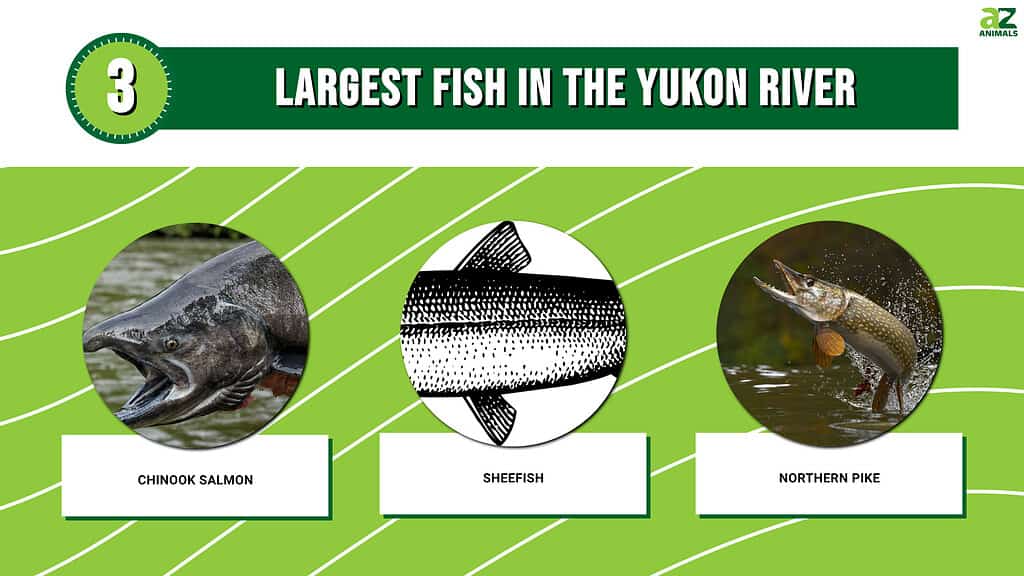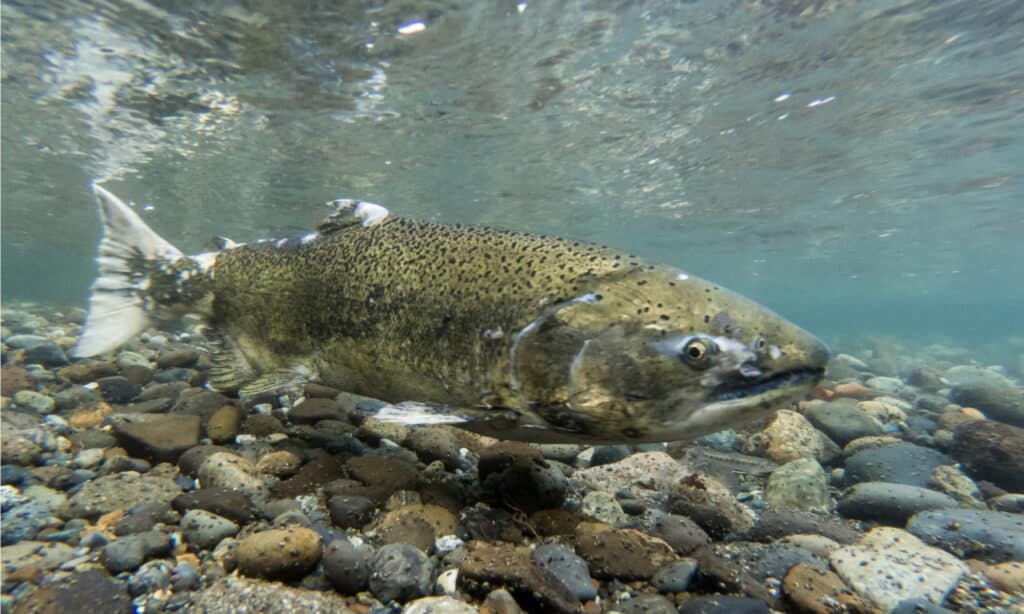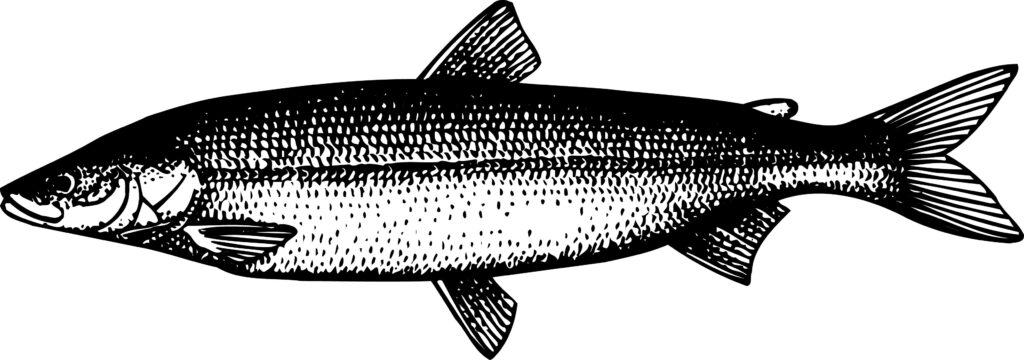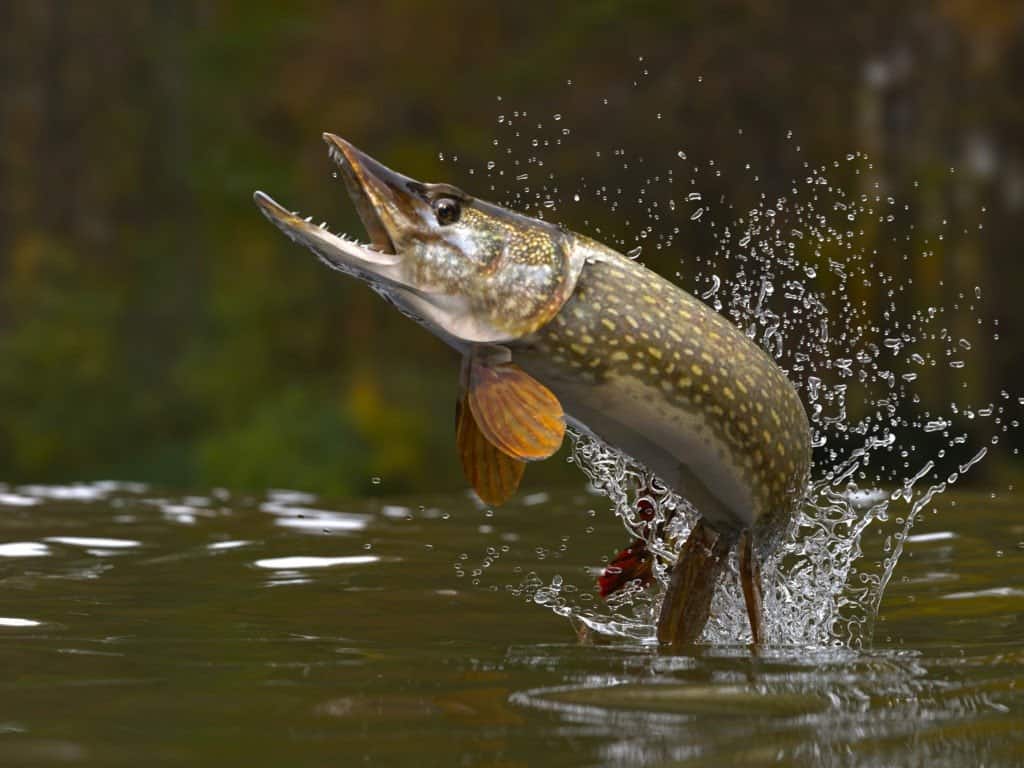
The Yukon River rises in northwestern British Columbia and flows through the Yukon and Alaska. The river measures 1,980 miles long, making it the 3rd longest river in North America. Its drainage basin covers an area of 321,500 square miles, an area larger than the state of Texas. The river gets its name Gwich’in phrase chųų gąįį han, which translates roughly to “white water river.” It gets its name from its pale-colored water due to its glacial origins.
The Yukon River supports various plants and animals along its banks and within its waters. Hundreds of birds and dozens of mammals, reptiles, and amphibians live within its drainage basin. The river also supports five Pacific salmon species and numerous other fish species, including trout, burbot, and whitefish. It features one of the world’s longest salmon runs, although its population has plummeted in recent years. This begs the question, what are the largest fish in the Yukon River?
In this article, we’ll discuss 3 of the largest fish in the Yukon River. We’ll also cover some tips and tricks for fishing on the Yukon River and what you can expect during a fish trip. Keep reading to discover river monsters that live in the Yukon River.
Fishing in the Yukon River

Whether you enjoy fly fishing, line fishing, or traditional rod-and-reel feeling, the Yukon River offers something for everyone.
©iStock.com/HeatherECampbell
Fishing in the Yukon River represents a unique opportunity for anglers. Its waters are well-stocked with various wild fish that require different methods to bait and catch. You can take a boat out on the river or fish along its banks or on one of its tributaries. Whether you enjoy fly fishing, line fishing, or traditional rod-and-reel feeling, the Yukon River offers something for everyone. Here are 3 of the largest fish that you can expect to find swimming in its waters.
1. Chinook Salmon

Chinook salmon have a long, tapered body with a blue-green back, a silver sheen on their sides, and a white belly.
©Kevin Cass/Shutterstock.com
Also known as the king salmon, Quinnat salmon, or spring salmon, the Chinook salmon (Oncorhynchus tshawytscha) is the largest species of Pacific salmon. It also ranks as the largest fish species in the Yukon River. Most adult Chinook salmon range from 24 to 36 inches long. That said, at maximum size, they can grow up to 58 inches in length. On average, they weigh between 10 and 50 pounds but can reach 130 pounds. They appear purple, red, or blue-green along the back and feature shiny silver scales. You can identify them by their large size and characteristic silver tails with black spots.
Chinook salmon are anadromous fish, meaning they live in fresh and saltwater. Shortly after birth, Chinook salmon travel downriver and enter the Pacific Ocean. While young, most Chinook salmon eat insects and small crustaceans. As they grow, their diet changes to mostly consist of other fish. Most Chinook salmon spend 3 to 4 years at sea, but some spend as few as 1 or as many 8 years at sea. Once they mature, they travel back upstream to their spawning grounds near Whitehorse, Yukon. Chinook salmon travel nearly 1,900 miles to their spawning grounds, the longest migration of any salmon species.
To make such an arduous migration, Chinook salmon require large fat reserves. This high-fat content makes them prized as commercial fish due to their lovely taste and high levels of heart-healthy omega-3 fatty acids. During their migration, Chinook salmon lose much of their fat, and their color darkens as a result. They prefer to spawn in cool, clean water free of sediment and high in oxygen. Unfortunately, due to overfishing, climate change, and habitat loss, Chinook salmon populations are declining. While the IUCN classifies Chinook salmon as a species of Least Concern, their steady decline indicates a worrying trend.
2. Sheefish

The sheefish (
Stenodus nelma) ranks as the largest species of whitefish in the Yukon River.
©Dn Br/Shutterstock.com
The sheefish (Stenodus nelma) goes by many other names, including the nelma, selfish, or connie. In the Inuit language, it goes by the name Inconnu, meaning “unknown fish.” A member of the family Salmonidae, it ranks as the largest species of whitefish in the Yukon River. At maximum size, they can grow up to 59 inches long and weigh up to 85 pounds. That said, most adult sheefish measure between 16 and 30 inches and weigh from 30 to 60 pounds. They sport large mouths, a distinctive underbite, and high, pointed dorsal fins. In terms of color, they appear mostly silver but often feature brown, blue, or green traces on their backs.
Like salmon, sheefish are anadromous. They breed in freshwater and then travel out to sea to grow and develop. That said, some sheefish spend their entire lives in freshwater and do not migrate out to sea. Those that do travel to sea often migrate up to 1,000 miles to reach their spawning grounds. As juveniles, they mostly survive on plankton and slowly start to prey on small fish as they grow. Unlike salmon, female sheefish do not always die after spawning. In fact, they can live up to 30 years in the wild. However, the energy required to lay hundreds of thousands of eggs means that they typically only spawn once every few years.
Anglers prize sheefish for their large size. You can catch them both with rod-and-reels during the spring or during the winter while ice-fishing. Sheefish meat is white, flaky, and somewhat oily. Some people compare its taste to halibut, while others say its meat is superior to other whitefish thanks to its buttery taste. Presently, sheefish populations appear stable, and the IUCN lists them as a species of Least Concern.
3. Northern Pike

On average, pikes measure between 16 and 22 inches long and weigh 5 to 10 pounds.
©bekirevren/Shutterstock.com
The northern pike (Esox lucius), or simply pike, is one of the most common fish in the Northern Hemisphere. It gets its common name from its long, pole-like shape, as it resembles a pike, a weapon commonly used in European warfare during the Middle Ages. On average, pikes measure between 16 and 22 inches long and weigh 5 to 10 pounds. That said, exceptionally large specimens can grow up to 59 inches long and weigh around 63 pounds. Northern pikes feature olive-green scales on their sides and back and yellowish-white bellies. Their fins occasionally appear reddish and sport light-colored bar-like marks down each side.
Northern pike can live in a wide variety of habitats. You can find them in slow-moving streams, high-vegetated lakes and ponds, and cold, rocky rivers. No matter where they live, northern pike typically stand at the top of the food chain. They often remain still for long periods of time and then quickly ambush their unsuspecting prey. As juveniles, they mostly eat small crustaceans like daphnia. Once they mature, their diet consists mainly of fish, frogs, crayfish, and insects. That said, they will also feed on waterbirds and small mammals and may even cannibalize other pikes. Due to their cannibalistic behavior, northern pikes have a high mortality rate. Those that do reach maturity can live up to 25 years.
Northern pike is a popular sporting fish due to its large size and aggressive behavior. That said, many anglers prefer to release captured pike rather than eat them. Although they have mild-tasting flesh, they are quite bony, which makes them rather difficult to cook and eat. Still, northern pike is commonly eaten in parts of Europe and North America. Due to their widespread distribution, the IUCN lists the northern pike as a species of Least Concern.
Tips for Fishing in the Yukon River
If you’re interested in fishing on the Yukon River, you should first make sure you do the proper research. Start off by identifying what types of fish you want to catch. This will help determine what time of year you should plan your trip and where you should attempt to fish. Local anglers often know the best spots and can point you in the right direction. Check out online message boards or consult with fishing tours to learn about top fishing spots.
Additionally, you’ll want to read up on the regulations regarding fishing on the Yukon River. The Yukon Territory and Alaska limit the fish you can catch from the Yukon River daily. Prospective anglers may be required to get a permit before fishing, and local governments may forbid fishing for certain species at certain times. For example, in recent years fishing for salmon has been banned on the Yukon River. Government authorities instituted these bans to protect salmon populations due to the low number of salmon returning to the river.
The photo featured at the top of this post is © bekirevren/Shutterstock.com
Thank you for reading! Have some feedback for us? Contact the AZ Animals editorial team.






